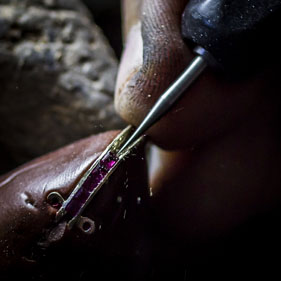
Chamber Talks
Artisanship-Design-Innovation
Relations in the Pursuit of İstanbul Jewellers:
“Living Human Treasures” of the Grand Bazaar
18 December 2014 / 18:30

Ayşe Coşkun Orlandi
Since the 2000s, Turkey has been second only to Italy among countries working gold into jewelry for export. The most important asset behind Turkey’s international success is the capability of working precious metals, which is the extension of the multi-layered cultural heritage located in Turkey, for every civilization of the region has left a legacy in jewellery. The production behind the international success of the last two decades comes almost entirely from the Grand Bazaar and the commercial buildings (“han”) around Nuruosmaniye. These buildings in and around Kapalıçarşı have become and continue to be the centre of jewellery production.
Since the Ottoman period, Kapalıçarşı has been the unchanging centre of mastery outside the palace, of individual handicraft of the pre-industrial era, and of the most delicate production. Masters from various parts of the empire opened shop in the Grand Bazaar and the buildings around it, creating the centre of jewellery in İstanbul. Greeks, Armenians, Persians, Assyrians, the Daghistani, Crimeans, and Cossacks created products that pleased the Ottoman taste. Producing for the Grand Bazaar and mass production are said to constitute two poles. The Bazaar became famous as the locus of special and different products (in the Ehl-i Hıref style). It is known that some of the masters here emigrated to France, Britain, and the States, and that some of the famous jewellers in these countries are Greek and Armenian masters from İstanbul. Throughout the 550-year long history of traditional production, the changes in social demographics has directly affected social, economic, and political contexts, and there have been discontinuities in traditional and original production techniques. Even though it is known that the jewellery production in the Grand Bazaar becomes valuable through workmanship and original production techniques, these are gradually being lost with the changing demographics structure, as attested to by old masters and shop owners.
The Grand Bazaar and the surrounding buildings where jewellery production continues have been studied in terms of urbanism, architectural history, and environmental engineering, but the production potential of the area has never been studied in terms of creativity, originality, and innovation. On the other hand, jewellery design has usually been the subject of art history along with traditional arts. The traditional jewellery production techniques of 550 years specific to the Grand Bazaar have been treated as part of the material culture of the Ottoman Empire, in terms of style and form within the historical context. In the 21st century, this traditional production of artisan roots has begun to turn into a sector, and production techniques that depended mostly on traditional handiwork have evolved into a fully automated process with the aid of new computer technology. The questions to ask from this vantage point are: How will this 550-year old traditional production survive in the face of technological advances? How will the Grand Bazaar jewellery catch up with contemporary design? How can the Grand Bazaar jewellery gain global recognition? The talk aims to present a current look at jewellery design by lifting the curtain of mystery on the workshops of masters who continue to produce using traditional techniques in the background of the Grand Bazaar jewellery.
Free of admissions, drop in. The talk will be in Turkish.

